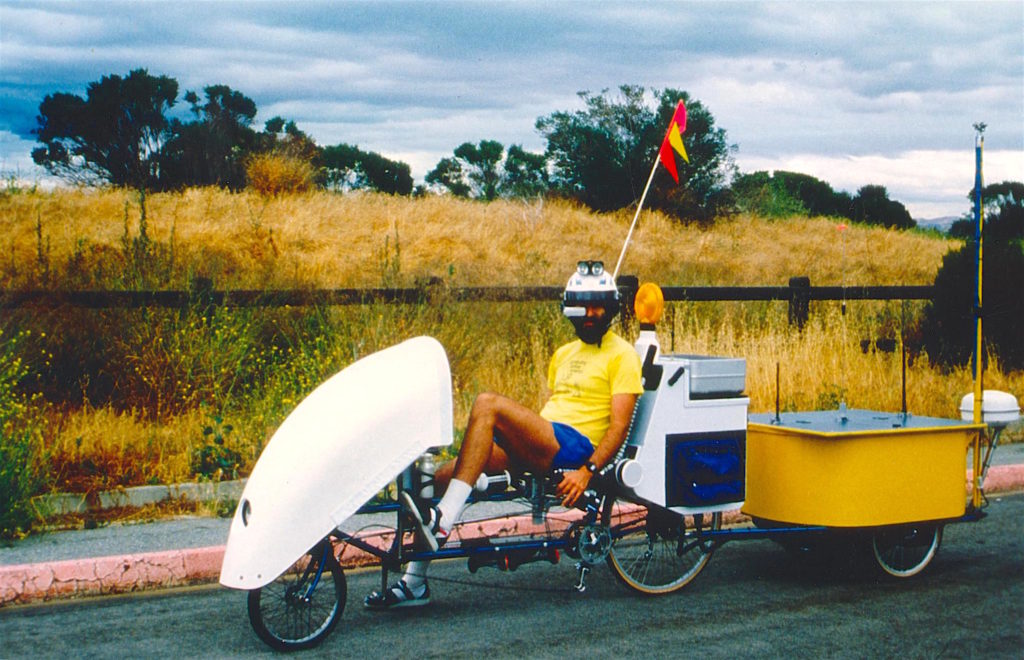
Bikelab Report #15 – The Mother of All Layovers
by Steven K. Roberts
Nomadic Research Labs
IN THIS ISSUE:
- High-tech Nomadness Returns!
- The Mother of All Layovers
- The Mothership
- BEHEMOTH Technical Update
- CELLULAR PHONE
- HAM STATION
- PNEUMATICS
- FORTH DEV SYSTEM
- UNIXCYCLE
- HP-95LX PALMTOP
“I’d rather be lucky than talented. Luck doesn’t take any work.”
—David Berkstresser, who never fails to come up with a quotable line in the middle of a pizza.
I keep getting glimpses of it. Sometimes it appears in images elicited by the music of my life, flashes of the Road encoded in CDs of my favorite travelin’ jams. Sometimes the reminders lurk in the smoldering eyes of a new friend, recalling the romance of beginnings, the magic of new places. If I’m sensitive, it takes but a sunny day and a passing bicycle; if I’m stressed, I have to get hit on the head by the poignancy of old writings or the intensity of new passions before I remember why I am. But always, somewhere below the surface, is the wanderlust — the ache for freedom. Strip away all the high tech and business clutter, and you’ll find me deep in love, still, with the Other Woman… The Road. She’s easy to take for granted, yet so potent in her effects that handling a tattered old road map can bring tears to my eyes.
It’s happening again at last. Friends have watched patiently for three and a half years, some helping with the project, others just asking in that quiet way if I’m ever going to travel again — their voices taking on the sort of tenderness associated with hesitant questions about relationships in transition. This whole Silicon Valley “layover,” nearly as long as my internment in Ohio suburbia, seems to have been one great inhalation: now, blue-faced, I strain toward the moment of release in a sort of eager panic. On April 15, I will shut the door of the Sun bikelab one last time and return to the road at last… full-time.
But things are different, this trip.
Road lust takes many forms, and I seem to experience most of them. You must understand: it’s passage away from HERE that is the lure — and not necessarily any particular HERE. Just HERE: wherever comfort has degenerated into complacency. (Oh yes, I’ve had some sweet layovers indeed — homes so lovely and warm that my wanderlust seems perverted.) But when restlessness grips you it cares nothing for your degree of comfort, only for the instinctive desire to GO… the innate quest for change.
This story is a watershed. For 3.5 years (!) I have been in the Silicon Valley area, taking a break from full-time travel to build the new bike. Of course it’s not finished — it probably never will be — but it is now far enough along that further development can take place on the road, away from the milling machine and Deep Clutter. And there now really is a nomadic research lab to justify my company name. But since so much time has elapsed since my previous reports, I think a quick timeline summary is in order before I tell you about what’s happening now…
The Mother of All Layovers
This all began in 1983, when the torpor of midwest suburbia became too oppressive, the concept of growing up had been exposed as a farce, and it occurred to me that a lifelong quest for passion was not such a bad idea after all. I built the Winnebiko and traveled solo for about 10,000 miles, taking me into 1985.
It was to have been only a short layover, but my Computing Across America book became ensnarled in the sleazy nightmares of the publishing business and I ran out of money. In Ohio I built the Winnebiko II and fell in love with Maggie… we hit the road together in 1986, taking a year and a half to pedal our recumbents 6,000 miles on both coasts. In early 1988 we hit Florida: my book finally came out, and we bought a 35-foot school bus to haul inventory around the country on the trade show circuit, living hand to mouth on book sales.
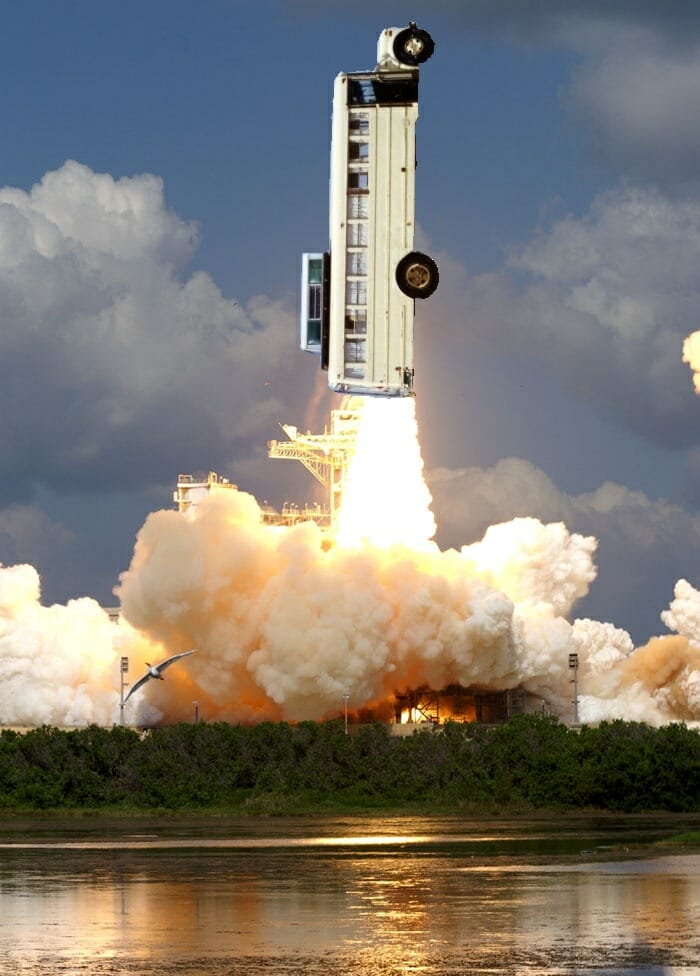
About 300 cubic feet of gasoline later, we rumbled into the San Francisco Bay area. It was the fall of 1988… and the plan was to find a place to spend a year building the new bike, then dump the bus and hit the road again. But this was a seriously ambitious project, and I underestimated it by about 75%.
We spent six months in Palo Alto, working in Alan Selfridge’s ping-pong room. Six months in Milpitas, sharing a rented house with Dave Berkstresser, designing circuitry in the living room and hacking fiberglass on the rear deck. Six months with Roger Grigsby in Santa Cruz, working in tiny bedrooms and a funky garage, doing the console metalwork and mounting boards. Then we languished happily for nearly a year in Soquel, renting a house with Dave Wright, working in space donated by Borland International and then moving back to the house — sweating over a desk in the school bus and puttering about in another dusty garage, feeling way too much like a homeowner clinging to the obsolete hobbies of youth. And then at last the breakthrough: a year and a half in a 1200 square foot lab provided by Sun Microsystems in Mountain View.
As lifestyles go, I cannot really recommend round-the-clock presence in a windowless fluorescent-lit corporate environment. But the resources have been first class, the company supportive, and the people stimulating. The project moved steadily along. Machines flickered to life, wizard friends spent late evenings running cables, machining, writing FORTH code, building boards, tweaking gears, running the CAD system, hacking the unixcycle, brainstorming… and it even began to seem that I would in fact get to pedal this thing again someday. In the summer of ’91 I trucked it to Iowa for an aborted attempt at RAGBRAI (blew a hub the first day), then proceeded more slowly on a test ride through Illinois, Wisconsin, and the upper peninsula of Michigan.
It was quite a reality check — in some ways thrilling, in others frustrating. Bike mechanical components were quickly proven to be the weak link, with the freewheel serving as the fuse in my drivetrain when I pushed too hard one afternoon on a hilly section of the Fox River Trail. Gravity was now more of a factor than ever before, with 780 pounds of stuff (including my body) to haul up every hill — although active helmet cooling, a 105-speed gear train, and pneumatically deployed landing gear helped take the sting out. But the brakes were inadequate, and in a curious way the computers were a pain because most of the on-board systems were yet unconnected and unprogrammed. Halfway up a killer Wisconsin hill on a 97-degree summer day, the words “dead weight” take on a sinister tone… more than once did I contemplate leaving a trail of useless gizmology in the ditch and breezing happily into the sunset.
But I managed to avoid that temptation, and in Lansing an interesting alternative presented itself: the mothership. The triggering event was the purchase of six Japanese books to support my language study — when the time came to pack the bike and pedal off to Ann Arbor and points south, BEHEMOTH’s trailer lid wouldn’t close. Aw hell. This got me thinking about the convoluted nature of this business, the other motives in my life, and the need to rapidly relocate the bike to trade shows, speaking gigs, interesting layover environments, and client sites (I had spent over $3,000 on rental trucks in the previous year). Within a few days, I was the owner of a GMC van and a 20-foot Wells Cargo trailer.
Zooming back to the lab for the final phase, I threw myself into the project once again… fighting the torpor of endless TO-DO lists, living a reminder of all the reasons I want to travel. Stress. Deadlines. Biz. The endless sameness of days spent in physical stasis, watching the contents of hard disks change to reflect the latest details of my life but otherwise experiencing time’s inexorable passage with growing impatience. But now, as I write this at the beginning of April 1992, I realize that I’m at the beginning of a whole new adventure, as unprepared as ever but deeply excited and anxious to get on with it.
So what’s all this mothership business? Am I about to betray my human-powered roots and become an industrial-strength RV’er? Steve Sergeant commented in the technomads alias that, “it was like the day the music died for me when Steve Roberts announced he was becoming a MOTORIST.” Time to explain…
The Mothership
One nice thing about having this lab at Sun is that it can support a lot of interesting projects that are impossible when living full-time on a bicycle. I have inventory, robust tools, and workspace. The cost, of course, is that I am immobile. Since the bike is an ongoing development project, I really do need workspace — and finding it on the fly while passing through an unfamiliar town can be extremely time-consuming. Quite simply, the mothership is a way to have the best of both worlds: a workspace that can be relocated on demand, serving as a mobile home base for a succession of shorter bicycle tours. This may seem to take something away from the grand adventure of open-ended bicycle travel, but it more than compensates by adding a layer of tools that render the entire project more flexible and intellectually stimulating (like allowing major book projects, consulting gigs, and system upgrades without requiring a year’s layover!).
It also adds another feature: rapid deployment to places I would otherwise avoid (cities). This becomes significant when dealing with the business side of this (um, you didn’t think that publishing the journal is my sole source of income, did you?) — I’m now working with a speakers bureau (Keynote Speakers), appearing at trade shows, and doing a bit of consulting here and there — some on-site, some nomadic. (Full list of speaking gigs here)
Now lemme tellya about the mothership!
This is becoming a serious toy. It’s happening in two stages: the current system, a 20′ trailer and an inadequate van, needs to be replaced. I can’t do this all at once without eliciting polite chuckles from bankers, so I’m trading the van for a robust truck and pressing on with the mobile bikelab… assuming that in a few months I’ll upgrade the latter to a 44′ Wells Cargo fifth wheel. These are not at all like RV’s, fortunately — I researched those in some detail and discovered that a huge percentage of their not-inconsiderable cost is attributable to the implementation of someone else’s idea of “home.” But I need a machine shop, bikelab, R&D environment, inventory area, office, and — oh yeah — a place to sleep and perform body-maintenance tasks. The Wells Cargo products should be investigated by any nomad who needs to define custom space… they build everything from empty boxes on wheels to concession wagons, auto carriers (like the racing teams use), mobile offices, and research vehicles.
My 20-footer has been configured with a suite of surplus workbenches and office furniture, occupying the entire left side and front end. Parts inventory lives in 500 tiny drawers and 32 Rubbermaid bins in a custom shelving unit. The bike lives on the right side, tied down with ratchet straps, and can be removed via a ramp stowed under the trailer (the big one will have a fold-down ramp door). A small solar panel is on the roof to keep the local battery (and the bike system) charged, and I’ve remoted the bike’s cellular and pager antennas via an umbilicus. A phone line from the bike’s CelJack cellular phone interface runs all the way to the driver’s seat, where a cordless phone with answering machine is velcro’d to the ham equipment rack. There’s a long way to go — this one will take care of the trip beginning on April 15, but the full project is much more ambitious (of course). I’ll tell you about it in detail as it develops, but suffice it to say that it will become a complete autonomous climate-controlled mobile lab, linked full-time to the internet, networked to the bike, and equipped with a full range of mechanical, electronic, and software development tools.
The current trip begins April 15 after a talk at the Idea ’92 conference, then takes me to Reno for a gig at the local ACM chapter. Then I zoom cross-country with visits in Utah and Colorado, arriving in Dayton just in time for the annual hamfest (the big one) — where I’ll display the bike in the PacComm booth and speak at the Icom FM bash. From there, I loop through Cincinnati, Louisville, Pittsburgh, and Richmond for a round of visits, then make my way to Washington DC for the Interop show in mid-May. Here, we’ll demonstrate the bike’s internetworking features (um, that is… whatever is working by then!) and do an interview with NPR’s “All Things Considered,” then, well, from there it gets vague. I’ll be back in Silicon Valley by October, probably long before, to implement the big trailer and hit the road once again. Hopefully, somewhere after Interop there will be time for a leisurely bike tour around Utah.
Yes, all this business stuff is the substrate that keeps me alive, but as I plan these mothership excursions the key thing is to leave large holes in my schedule to accommodate adventures more satisfying than the quest for 60-foot parking spaces in unfamiliar cities. The bike is still the focus of the whole affair, and even though it’s networked with mothership and backpack in a multilayered nomadic system, it still comes into its own when it’s out on the road, lumbering along under human power, computing and communicating on the captured energy of sunlight. As this journal continues to evolve in both print and electronic forms, the spirit of BEHEMOTH will remain the focus — even as we diverge into all sorts of related tools and techniques that apply to a wide range of nomadic needs.
BEHEMOTH Technical Update
Deadlines are amazing things. I can mess around for months, taking up my time with schmoozing, planning, scheming, and reshuffling, never seeming to make any real headway. Then a departure date looms and the project shifts into focus, help materializes, and things get knocked off the TODO list at the rate of 3 or 4 a day. Here’s what’s been going on with the bike…
CELLULAR PHONE
The cellular phone is now alive and in use whenever I’m pedaling or driving the mothership — and the key component is the CelJack from Telular.
This lives between the handset and the transceiver of my Oki 491 phone, and provides a completely standard RJ-11 modular jack interface. It has the look and feel of a normal phone line: plug in a desk phone, call the bike, and the bell rings.
The wonderful thing about this is that all sorts of devices that were not designed to work on cellular phones now work just fine. I run the line around the bike (and off-bike as well), and have used it with the Touchbase 2496 fax/modem, the Telebit CellBlazer, the Panasonic cordless phone with answering machine that’s now Velcro’d under the fairing, and — most twisted of all — the credit card terminal. That’s right… in Seattle last month, I met a guy on the street who subscribed to the journal — I just took his plastic and did the transaction on the spot. Ain’t technology wonderful?
Of course, I still think the cellular industry itself is full of serious bugs. The fact that a 576-page “Cellular Telephone Directory” is a necessary adjunct to full-time roaming is absurd. This is an appliance, and should feel like one. Unfortunately, every vendor of airtime has a better way to do things, and none of them are either compatible or obvious to the user. The concepts of online help and consistent user interface have obviously never occurred to them.
HAM STATION
I’ve interfaced the CMOS Super Keyer with the Bencher paddle and the Icom 725, and it works beautifully. Performance of the HF system continues to amaze me: good DX is now quite routine. I worked a station in China during a photo session last week.
Things are still not ready for integrated bicycle mobile operation, but Joe Dunn built the last two audio crosspoint boards and Dave Harris is continuing to weave all the cabling into a completed network. Software power control is working fine, and the whole thing is finally starting to feel like a system.
PacComm just sent their delightful new Handi-Packet unit — a tiny full-function TNC that comes with a belt clip and internal 12-hour NiCd battery. This is literally plug-and-play: I plugged the provided cables into my HP-95LX palmtop and Icom IC-24 transceiver, and it worked. It has KISS mode and an internal mini-BBS as well. A complete packet system in a fanny pack or briefcase is now essentially off-the-shelf technology… and don’t forget that a number of packet-to- internet gateways are now online. Things keep getting more and more interesting….
On the ham radio theme, I apparently agreed in a weak moment to appear at the Dayton Hamfest this year — I’ll have the bike in the PacComm booth and speaking Friday night at the Icom FM Bash. If you’re there, come say hello!
PNEUMATICS
I did it. My arm kept getting tired from pumping up the air tank for the pneumatic landing gear and the horn — there’s a slow leak I just can’t seem to track down. The bike now has a small compressor that converts photons into air pressure. It’s the little things that add up….
FORTH DEVELOPMENT SYSTEM and MAC STATUS
More progress on the bicycle control system! Thanks to Mike Perry’s expert help, the whole development environment for FORTH is now in the console Mac— using the slick script language that’s part of Microphone II. It’s now so quick and easy to hack code that I really want to finish this update so I can get back to it. HyperTalk will still be the graphic user interface during normal operation, but we found that using it to manage all the handshaking of program downloads was, well, let’s just say a bit too leisurely to be effective.
The other Macintosh news is that the handlebar keyboard is at last alive. Jay Hamlin and the folks at Infogrip have completed a Mac version of the BAT chord keyboard, and we wired the processor onto the BCP’s nexus board. Now I have no excuse for putting off the learning curve on the new chording scheme… I can finally type while riding again!
The mouse is another matter — the ultrasonic head mouse from Personics just isn’t doing the job. Apparently, the problem is no fault of the manufacturer — Steve Sergeant probed around in the circuit and noticed serious phase jitter coming from the sensors on my helmet. We’ve concluded that this is a result of excessive cable length and EMI from the BCP, and Steve wants to try adding filtration. I’ve been playing with Logitech’s amazing new 6D ultrasonic mouse, but it may be overkill for the application — I’m about to try (hopefully) the new gyroscopic unit from Gyration. This would let me send high-level quadrature from the helmet instead of tiny analog signals, eliminating the negative effects of a long wiring harness and road noise.
UNIXCYCLE
The bike’s SPARCstation has been a major issue for quite a while, and it is now alive on the bench with a monochrome display from RDI. I also just acquired the new Sharp TFT active matrix color LCD, which is dramatically beautiful — as well as an RDI SBUS card to control it. All this was intended to replace the 286 system in the console.
But that involves major mechanical surgery, so an interim solution is now underway with the help of a group of engineers here at Sun. We’re building the SPARC into the Zero aluminum case (with solar panel) that rides atop the bike’s RUMP. This system has 424 Megabytes of disk, both screens packaged in a folding two-headed windowing environment, the new 9600-baud Motorola Radius wireless modem, keyboard, trackball, and external ports for CDROM, serial comm, ethernet, and floppy. It’s not quite the same as being able to run it while pedaling, but in all fairness, this system is more for the heavy-duty computing tasks like high-speed daily internet mail transfers, still video, mapping, and CAD — not on-the-road text editing and routine satellite and RF data communication. It won’t kill me to stop and open a pack, I guess. 😉
The only problem with this approach is that it displaces office stuff that lived in that case… but that can all move to the trailer and displace the now-obsolete DOS laptop (the SPARC can emulate DOS, and I still have the 286 running the Private Eye).
HP-95LX PALMTOP
Finally, my favorite new personal accessory is the HP-95 palmtop, which is the first pocket computer that I’ve found useful enough to want with me 24 hours a day. I don’t have the space here for a full review, but I’ve gotta tellya — they did a beautiful job. It’s easily interfaceable via serial or infrared link, accepts the PCMCIA cards, and has a whole suite of useful applications in ROM: filer, communications, appointment manager, address book database, text editor, Lotus 123, and a robust scientific calculator with solver. These can all coexist and hot-key back and forth, meaning that you don’t have to close one operation to deal with another. You can shell to DOS if you like. And new applications can be installed… like a full dictionary and the Mobile Data Link.
MDL is magic. I keep the 95 in a cradle that also carries the Motorola NewsStream pager (stylistically compatible). There’s a serial link between them, and the pager is on a national Skypage account. Now, if someone wants to send email to my pocket, it can be done by logging on to 800-SKYWORD and entering my PIN… or just using an internet gateway that automates the process. By prefacing message text with special codes, items can be added to my TO-DO list, appointment book, 123 spreadsheets, etc. A friend at HP gets hourly stock quotes this way.
Of course, this is receive only… but that’s a temporary limitation. I had a chance to see the Mobidem, which plugs into the 95 and provides a BIDIRECTIONAL email link via radio. I’ll keep you posted…
That’s all for now — back to work! Next time you hear from me, it will be from somewhere Out There. Now that I’m wandering again, I’m interested in speaking gigs and interesting adventure or learning opportunities… See you on the road…




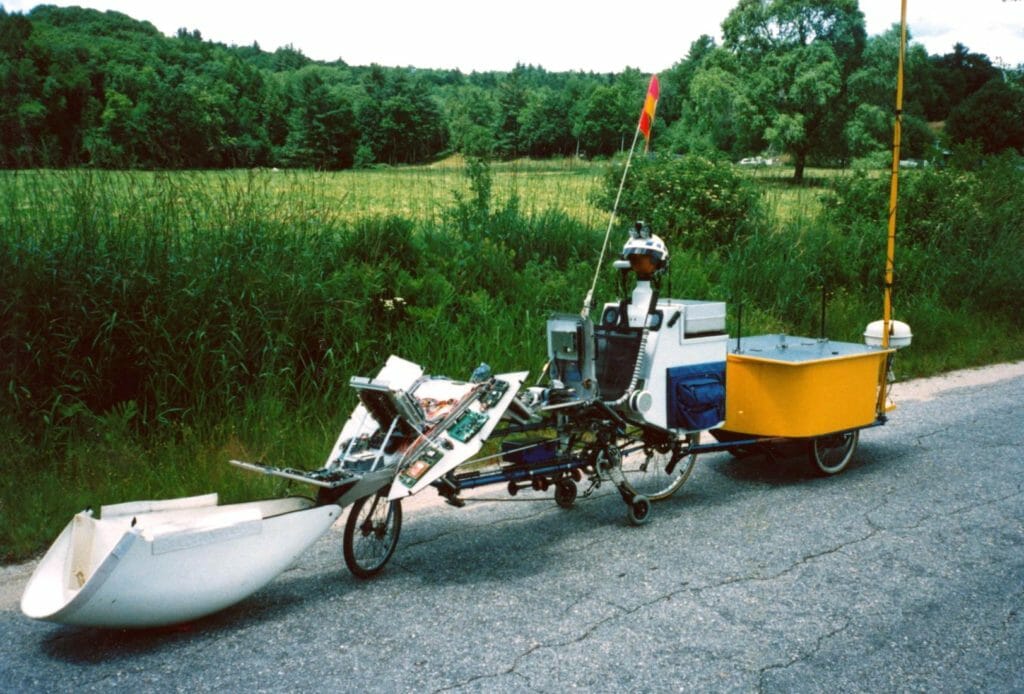
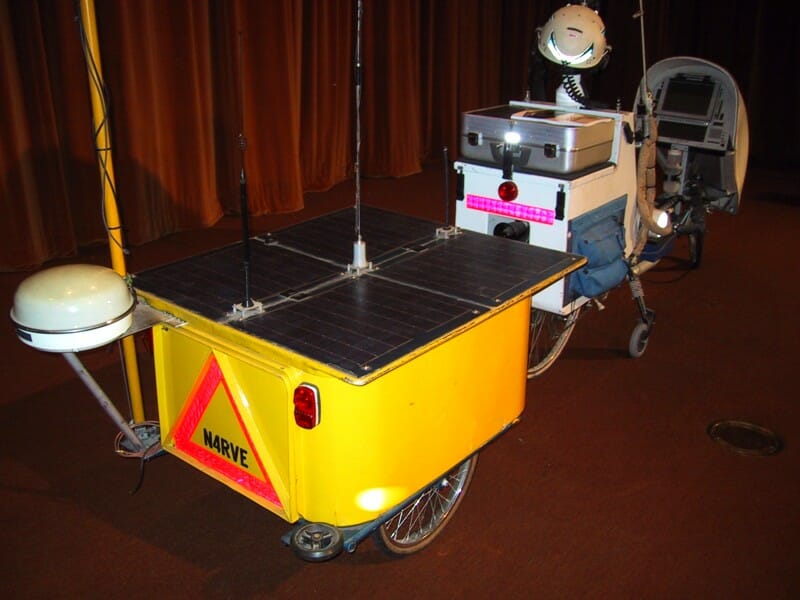
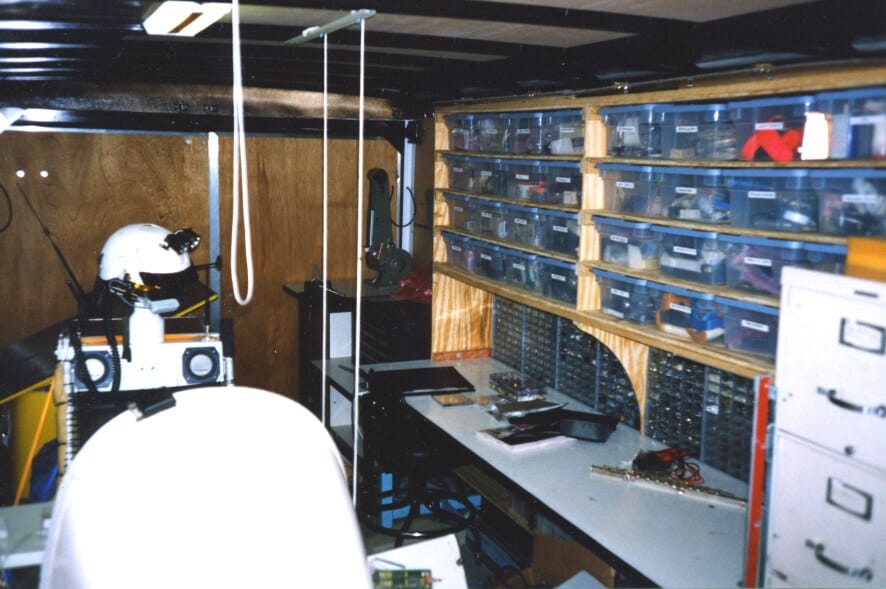

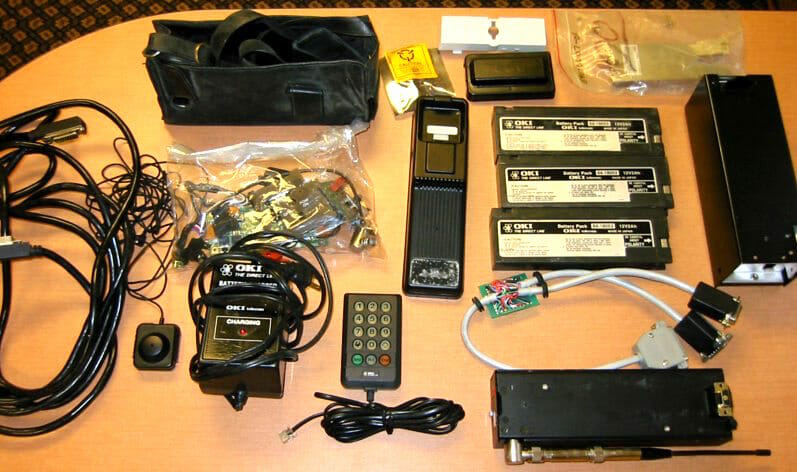
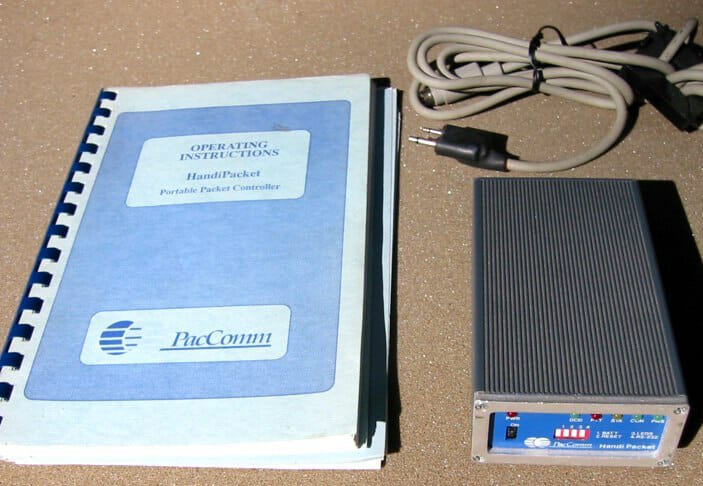
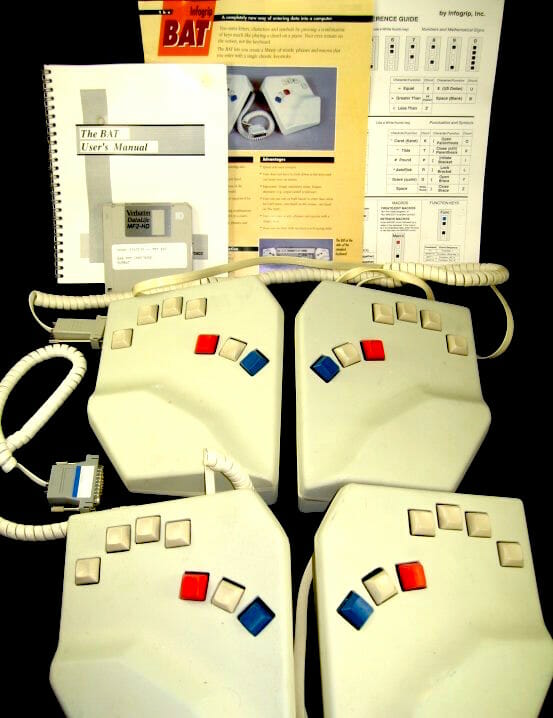
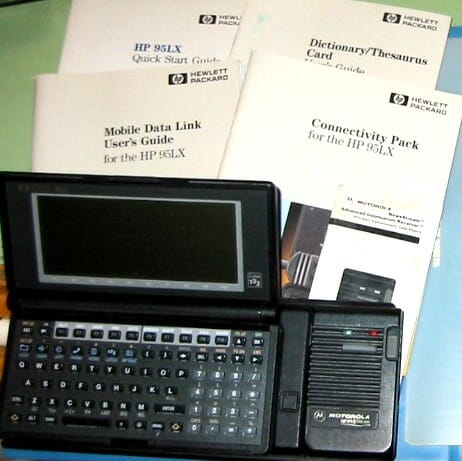
You must be logged in to post a comment.